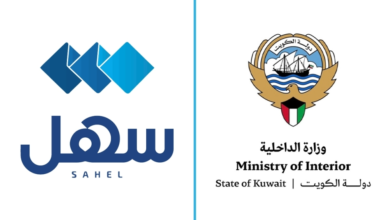
-
The US Federal Reserve’s delay in cutting expected interest rates is increasing the profitability of Gulf banks this year, as net interest margins remain larger than expected.
-
While most countries have struggled with high inflation and recession fears, the Gulf has shown remarkable resilience in energy prices, inflation, and interest rates.
-
Standard & Poor indicates that every 100 basis point decrease in interest rates reduces, on average, about 9% of the net profits of Gulf banks.
Despite concerns over potential global interest rate cuts, Gulf banks are currently experiencing some of the best conditions in years, according to a report by MEED magazine, as reported by Al Qabas newspaper.
The report indicated that the region’s banks are also benefiting from decisions taken elsewhere. The US Federal Reserve’s delay in cutting expected interest rates is increasing their profitability this year, as net interest margins remain larger than expected.
“There is more to it than just favorable external conditions,” the report continued. “The GCC has emerged as one of the brightest spots in the global banking system, for reasons that go beyond a favorable interest rate environment.”
“There is strong government spending in the Gulf, and the non-oil economy is also strong, which translates into strong investor and consumer confidence and favorable business conditions, especially as lending growth in most countries in the region is very reasonable at around five to six percent,” Redmond Ramsdale, head of bank ratings in the Middle East at Fitch Ratings, was quoted as saying by MEED.
“While most countries around the world have been struggling with high inflation and fears of recession over the past three years, the Gulf region, by contrast, has emerged as a highly resilient region with respect to energy prices, inflation, and interest rates,” said Badis Chebilat, senior financial analyst at Moody’s.
Gulf banks show strong resilience
The report indicated that Gulf banks continue to show strong resilience thanks to their supportive economies—especially in Saudi Arabia and the UAE—and relatively low inflation.
“Most banks are benefiting from higher interest rates for a longer period, and we now expect the US Federal Reserve to start cutting only in December 2024, which means profitability will continue this year. The negative impact of low interest rates on profitability will be the story of 2025,” said Mohamed Damak, chief financial analyst at S&P Global Ratings.
He continued, “The issuance of the dollar at a record level in the region reflects good pricing conditions, lending growth, and strong refinancing needs.”
Gulf banks feel headwinds
The MEED report noted that Gulf banks are still feeling some headwinds, especially when interest rate cuts finally begin in the second half of 2024.
Damak expects three rate cuts from Standard & Poor’s, totaling 75 basis points in the second half of the year, followed by another 125 basis points in 2025.
The report explained that since the central banks in the Gulf countries have kept pace with the tightening of monetary policy in the United States in recent years, which has had the effect of boosting banks’ profits, this means that profits will be reduced.
The global credit rating agency Standard & Poor’s indicates that every 100 basis point decrease in interest rates reduces, on average, about 9% of the net profits of Gulf banks.
However, the report sees several factors that could mitigate the overall impact, as low interest rates are also likely to reduce the size of unrealized losses that Gulf banks have accumulated over the past two years.
Kuwait’s banking sector sees net income surge to $1.34 billion in Q1 2024
The report stated that the banking sector in Kuwait witnessed an increase in net income to $1.34 billion in the first quarter of 2024, compared to $1.26 billion in the first quarter of 2023, after banks increased their efforts to collect local private sector deposits with the aim of creating less expensive financing in anticipation of increased economic activity.
The report noted that while loan growth in Saudi Arabia and the UAE remains robust thanks to a supportive economic framework, this is not the case for all GCC countries.
However, credit growth is accelerating in Qatar, with Fitch Solutions expecting it to rise from a record low of 2.8% at the start of 2023 to four percent by the end of 2024, due to stronger demand across many sectors and a slower pace of loan repayments.
Loan growth is expected to increase to 5% year-on-year by the end of 2025, due to lower borrowing costs. Stronger credit growth in Qatar should drive asset growth higher in 2024 and 2025.
In Bahrain, S&P expects private sector credit to grow by four percent over 2024-26, supported primarily by government housing programs.
In Oman, on the other hand, banks will struggle to keep up with the strong earnings improvement seen in 2023, when listed institutions reported an overall 18.6% year-on-year increase in net profits to $1.17 billion.
Fitch expects asset quality metrics to improve slightly this year due to favorable operating conditions, while write-offs will reduce the sector’s NPL ratio.
Legitimate optimism
Overall, lenders in the Gulf can be optimistic about their current position—even if the benign conditions of 2022 and 2023 are not repeated, in a world where the Fed is focused on cutting interest rates, MEED revealed.
Gulf banks enjoy favorable and low-cost funding
The report stressed that Gulf banks typically enjoy very favorable and low-cost funding, and this may continue in large banking systems, such as those in Saudi Arabia and the UAE, which account for two-thirds of the region’s banking system assets.
The favorable operating conditions in the Gulf also indicate that credit costs will remain low, which should also support strong profitability. However, the results of the first quarter of 2024 show a decline in revenues for the first time in three years.












